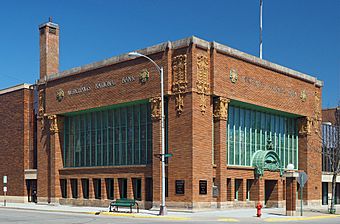Merchants National Bank (Winona, Minnesota) facts for kids
|
Merchants National Bank
|
|
|
U.S. Historic district
Contributing property |
|

Merchants National Bank from the southwest
|
|
| Location | 102 East 3rd Street, Winona, Minnesota |
|---|---|
| Area | Less than one acre |
| Built | 1912 |
| Architect | William Gray Purcell, George Feick, Jr., and George Grant Elmslie |
| Architectural style | Prairie School |
| Part of | Winona Commercial Historic District (ID98001220) |
| NRHP reference No. | 74001045 |
Quick facts for kids Significant dates |
|
| Added to NRHP | October 16, 1974 |
| Designated CP | October 1, 1998 |
The Merchants National Bank building is a cool old bank in Winona, Minnesota. It was built way back in 1912. This building is special because of its unique Prairie School style of architecture. It has amazing decorations made from terracotta (a type of baked clay) and colorful stained-glass windows.
The bank was added to the National Register of Historic Places in 1974. This means it's an important historical site for its architecture and business history. Experts say it's one of the best examples of banks designed by the famous architects Purcell, Feick & Elmslie. Their work really changed American architecture in the early 1900s. This building is also part of the Winona Commercial Historic District.
What Does the Bank Look Like?
The architects William Gray Purcell, George Feick, Jr., and George Grant Elmslie designed this bank to look strong and dependable. They wanted bankers and customers to feel safe and impressed. The building's design also showed how important farming was to the area. You can see sculptures of grain made from terracotta on the outside. Inside, there are murals (large paintings) of farm scenes. These were painted by their friend, Albert Fleury.
Right above the main entrance, a terracotta eagle sits proudly. Inside the bank, sunlight shines through beautiful stained-glass window walls. There's even a skylight (a window in the ceiling) that lets in more light. Tall lamps with round globes also light up the space. Purcell used some of these cool design ideas in another house he built a year later, called the Edna S. Purcell House.
Why Is This Building Important?
For a long time, American buildings like banks and government offices copied European styles. They often used neoclassical columns and triangular tops called pediments. These designs were meant to show how strong and serious these places were.
But the Merchants National Bank was different! It looked to American ideas for its design. It was inspired by the unique American architecture of Louis Sullivan and the Prairie School style of Frank Lloyd Wright. Sullivan's 1908 National Farmer's Bank of Owatonna showed how well American style could work for banks.
The Winona bank was very unusual for its time and place. Most buildings in this busy river town were in the Victorian style. But the bank looked like a simple cube, which was very new and surprising. It had terracotta decorations that looked like plants, not classical designs. Stained glass was usually only found in churches. But here, it was used a lot in big windows and the ceiling. This made the sunlight glow with many colors inside.
Even though it was unique, the building also fit right into Minnesota. It used earthy brick and terracotta. This reminded people of the town's history of making bricks. Large murals on the walls showed river scenes and the bluffs (cliffs) of Wisconsin. These pictures celebrated the natural beauty that first brought people to the area. Because it was so special and connected to its home, this amazing American-designed building made people in Winona and Minnesota feel very proud.





